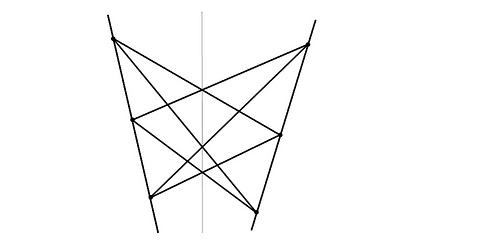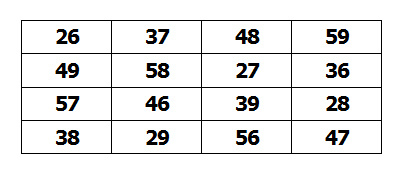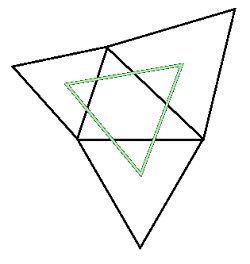
Jean Buridan presented a logical proof of the existence of God:
- God exists.
- Neither of these sentences is true.
The two statements can be reconciled only if God exists.
But see Cloudy, Kangaroo Court, and Powerless.

Jean Buridan presented a logical proof of the existence of God:
The two statements can be reconciled only if God exists.
But see Cloudy, Kangaroo Court, and Powerless.

A dust storm approaches Spearman, Texas, April 1935. Vance Johnson, a resident of western Kansas in the 1930s, described similar storms there:
The darkness was dust. The windows turned solid pitch; even flower boxes six inches beyond the pane were shut from view. … Dust sifted into houses, through cracks around the doors and windows — so thick even in well-built homes a man in a chair across the room became a blurred outline. Sparks flew between pieces of metal, and men got a shock when they touched the plumbing. It hurt to breath[e], but a damp cloth held over mouth and nose helped for a while. Food on tables freshly set for dinner ruined. Milk turned black. Bed, rugs, furniture, clothes in the closets, and food in the refrigerator were covered with a film of dust. Its acrid odor came out of pillows for days afterward.
During a dust storm in January 1895, J.C. Neal of Oklahoma A&M College reported “flashes of light that apparently started from no particular place, but prevaded [sic] the dust everywhere. As long as the wind blew, till about 2 a.m., January 21, this free lightning was everywhere but there was no noise whatever. It was a silent electrical storm.”
Draw any two lines, pick three points on each, and lace them all together like so:

The crossings of the laces will always form a straight line.
One day in 1939, Berkeley doctoral candidate George Dantzig arrived late for a statistics class taught by Jerzy Neyman. He copied down the two problems on the blackboard and turned them in a few days later, apologizing for the delay — he’d found them unusually difficult. Distracted, Neyman told him to leave his homework on the desk.
On a Sunday morning six weeks later, Neyman knocked on Dantzig’s door. The problems that Dantzig had assumed were homework were actually unproved statistical theorems that Neyman had been discussing with the class — and Dantzig had proved both of them. Both were eventually published, with Dantzig as coauthor.
“When I began to worry about a thesis topic,” he recalled later, “Neyman just shrugged and told me to wrap the two problems in a binder and he would accept them as my thesis.”

Each row and column in this magic square totals 170.
If you update the contents of each cell by spelling out its number in English, counting the letters and recording the result (26 = TWENTY-SIX = nine letters = 9), you’ll produce another magic square.

“Sometimes I think we’re alone in the universe, and sometimes I think we’re not. In either case the idea is quite staggering.” — Arthur C. Clarke
Adam and Noah exist here now. Adam lives to be 930, Noah 950. We can imagine a possible world in which they swap ages and yet retain their essential identities. But we can also imagine a further world in which they swap ages and names; another in which they swap ages, names, and hat sizes; and finally a world in which Adam and Noah have swapped all their qualitative properties.
Now isn’t Adam in our world identical with Noah in the other world? For how are they distinct? If a thing can retain its essential identity when a single property is changed, then, writes Willard Van Orman Quine, “You can change anything to anything by easy stages through some connecting series of possible worlds.”
See Spare Parts.
Three patricians of the coal yards fared forth on mercy bent, each in his great black chariot. Their overlord, the yard superintendent, had bade them deliver to seven families a total of twenty-eight tons of coal equally divided.
Well out of the yards, each with his first load, Kelly and Burke and Shea paused to discuss the problem of equal distribution — how much coal should each family get?
”Tis this way,’ argued Burke. ”Tis but a bit of mathematics. If there are 7 families an’ 28 tons o’ coal ye divide by 7, which is done as follows: Seven into 8 is 1, 7 into 21 is 3, which makes 13.’ He triumphantly exhibited his figures made with a stubby pencil on a bit of grimy paper:
The figures were impressive but Shea was not wholly convinced. ‘There’s a easy way o’ provin’ that,’ he declared. ‘Ye add 13 seven times,’ and he made his column of figures according to his own formula. Then, starting from the bottom of the 3 column, he reached the top with a total of 21 and climbed down the column of 1’s, thus; ‘3, 6, 9, 12, 15, 18, 21, 22, 23, 24, 25, 26, 27, 28.’ ‘Burke is right,’ he announced with finality.
This was Shea’s exhibit:
‘There is still some doubt in me mind,’ said Kelly. ‘Let me demonstrate in me own way. If ye multiply the 13 by 7 and get 28, then 13 is right.’ He produced a bit of stubby pencil and a sheet of paper. ”Tis done in this way,’ he said. ‘Seven times 3 is 21; 7 times 1 is 7, which makes 28. ‘Tis thus shown that 13 is the right figure and ye’re both right. Would ye see the figures?’
Kelly’s feat in mathematics was displayed as follows;
‘There is no more argyment,’ the three agreed, so they delivered thirteen tons of coal to each family.
— Irvin S. Cobb, A Laugh a Day Keeps the Doctor Away, 1923

Construct equilateral triangles on the sides of any triangle, and their centers will form an equilateral triangle. (This also works if you construct the triangles inward rather than outward. This triangle has the same center as the outward triangle, and the difference in their areas is the area of the original triangle.)
This discovery is traditionally credited to Napoleon, but there’s no evidence supporting that contention. Indeed, this theorem is said to be one of the most frequently rediscovered results in mathematics.
See A Better Nature.